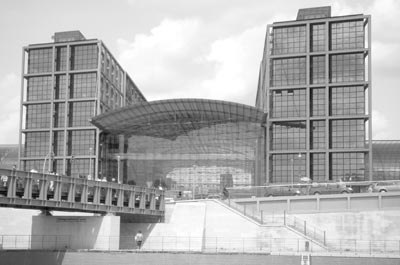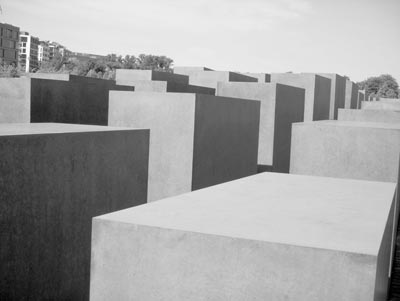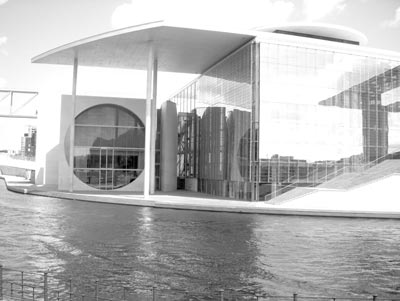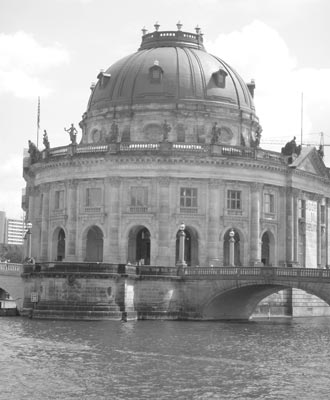New welcome to Berlin
by Jay Brunhouse
When your high-speed ICE train arrives (or a TXL airport bus drops you) at Berlin’s 2005 Hauptbahnhof (Hbf, or main train station), walk out the Washingtonplatz exit. The panorama you see is stunning. All of Berlin seems to lie at your feet.
East Berlin’s television tower rises in the distance. The new Government Quarter gleams across the Spree River, and the magnificent glass dome of the Reichstag is a short walk farther. And below you, the white sightseeing ships on the Spree River are loading and unloading passengers.
From Berlin’s Tegel Airport, bus TXL takes you directly to the Hbf’s Europaplatz entrance. At the Berlin InfoStore that you see sharp on your right, English-speaking agents will book you a hotel room for a service charge of €3 and/or ticket you on one of those sightseeing ships.
You may board an S-Bahn (rapid transit) train on the station’s top level or proceed through the station to the Washingtonplatz exit, where you can catch express bus M41 to the historic Brandenburg Gate, glitzy Potsdamer Platz or the multicultural district of Kreuzberg or farther into the working-class district of Neuköln.
The Hauptbahnhof — a train palace — has five levels and escalators that take you to every corner as well as panoramic elevators that few seem to prefer. In addition to the Berlin InfoStore on the ground floor, straight ahead from the Europaplatz entrance an officer at the GermanRail (DB) Service Point will answer your train questions and direct you to your train.
On the first level below ground level, find DB’s complete Reise Zentrum (travel center) for domestic and international ticketing and for validating your railpass. Shops, fast-food franchises and auto-rental agencies stretch the full length of this level. Proceed to the lowest level to board north-south ICE and regional trains. You may use the coin lockers there, as well.
The first level above ground level is like a mezzanine with long lines of shops, a good-feeling fast-food restaurant, a second Reise Zentrum and an S-Bahn office for S-Bahn information and public transportation tickets covering S-Bahn trains, U-Bahn (subway) trains and buses.
The top floor is the point of arrival and departure for east-west ICE, regional and S-Bahn trains. There are ticketing machines for local and regional trains, but don’t forget to validate your ticket by stamping it in the red validating machine nearby.
The Spree River
On the ship’s loudspeaker you can hear Marlene Dietrich singing “The Spree keeps on flowing through Berlin.” It told Berliners of the ’20s about the beautiful aspects of their city and encouraged those without “a cent to their name” to simply stay at home for their holidays.
Berlin was built in the 12th century on low-lying land crisscrossed by streams and rivers. Successive electors, kings and kaisers dug canals to reclaim the land and improve commerce. Berlin now has 62 lakes and 127 canals and waterways with more than 1,000 bridges over them — more than Venice.
Cruising the rivers and lakes aboard sightseeing ships takes you among the historic buildings that make Berlin special and past the lakes and beaches of the outlying areas. This only became possible with the reunification of divided Berlin. During hard times, the Spree River itself comprised part of the “Wall.”
Cruising up- and downstream gives you a new perspective on Berlin and allows you to cram as much as possible into a short time. From water level, you appreciate the interconnection between important historic buildings. You come so close to some historic buildings that you can reach out and touch them. Passing through the historic center, you rise and descend in locks dating from the Middle Ages.
Aboard cruise ships, you see the beautiful historic buildings and the stunning architecture of the Government Quarter in Berlin Mitte — you were never ever better able to do this. The problem with seeing historic buildings from the river is that they seem to beckon to you to get out and visit them.
Boats cruise beneath the Mühlendamm Bridge into the beginnings of Berlin and its ancient rival city, Colln, past the Nikolai Quarter, under the Schloßbrücke decorated with Schinkel’s neoclassical sculptures, under Liebknecht Bridge and around Museum Island.
You can use cruise vessels to the landing at Potsdam (to see Sanssouci), to Köpenick (for the town hall and palace), to Treptower Park (for the Soviet Memorial) and to Charlottenburg (for the palace).
On the river you see prewar wooden sailboats, their mahogany immaculately maintained, Fiberglas and plastic cruisers and commercial barges. You pass nude beaches and about 20 beach bars that turn the banks of the Spree into a booming, attractive “Berlin Copacabana.”
New Government Quarter
The cutting-edge, 21st-century offices for parliamentary groups, committees and members of Berlin’s parliament as well as for the administrative apparatus of the German Bundestag that were built following parliament’s decision to move from Bonn to Germany’s “new” capital turn the Bend of the Spree River (Spreebogen) north of the Reichstag building into a legislative heaven.
This ensemble of 6-story buildings does not exceed Berlin’s traditional maximum height of 72 feet (22 meters). In total, the complex provides about 1,700 offices for parliament members, committees, archives, visitors’ services, a school for parliament ministers’ children, and restaurants.
The parliamentary library is the third largest in the world, after those of Washington, D.C., and Tokyo. With 1.2 million volumes and 11,000 periodicals, the library is reserved for authorized visitors.
The New Government Quarter, which was known as the Federal Government River Walk (Band des Bundes) project, was designed by architects Schultes and Frank. It crosses the Spree River at two points and not only connects the Federal Chancellor’s Office (Bundeskanzleramt), built 1997-2001, to the offices for the members of the Bundestag in the Paul Löbe building, built 1997-2001, but bridges East and West Berlin and connects three very different districts that had been separated by the Wall for 40 years.
GTM Berlin
Berlin and Potsdam cohosted the 33rd German Travel Mart (GTM), Germany’s most important sales platform, in 2007. More than 650 buyers (the largest turnout came from the United States) and journalists from 45 countries joined 366 suppliers to exchange information, learn the latest travel information about Germany and confirm tour arrangements face to face.
Petra Hedorfer, CEO of the German National Tourist Office, welcomed guests during opening ceremonies in the Theater am Potsdamer Platz. The 1999 contemporary theater features mainstream conventional productions, mostly in the German language. It was designed by Renzo Piano with nearly 1,800 seats and is one of Berlin’s largest.
The 2-day workshop, which formed the heart of the GTM, was held in the Estrel Convention Center in the Estrel Hotel. The hotel was built by the German Democratic Republic in 1994 to accommodate hordes of visitors and is still Germany’s largest hotel, with 1,125 rooms, a busy 1997 Festival Theater and a spacious 1999 convention center.
Journalists from the United States stayed at the 5-star InterContinental Berlin (www.berlin.intercontinental.com), with room rates from €140 (approx. $208) and near the regional train station Zoo in the heart of West Berlin.
I thank the German National Tourist Office (www.cometogermany.com) for inviting me to the GTM. Lufthansa provided transatlantic transportation.
The long-delayed and revised third edition of Jay Brunhouse’s “Maverick Guide to Berlin” was released in February by Pelican Publishing and is available online and from travel bookstores.




